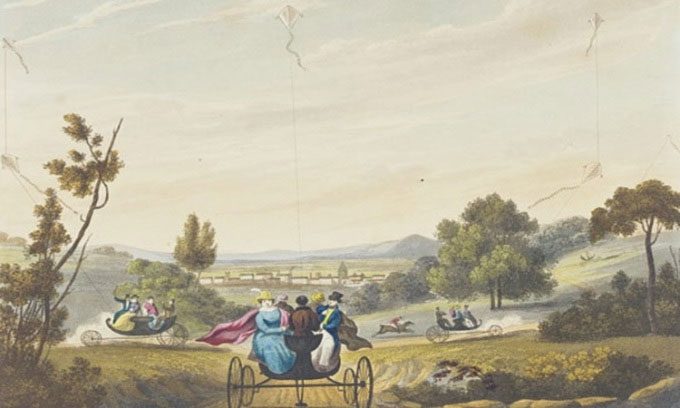From a passion for kites, an English teacher invented a kite-powered cart that could travel at 32 km/h in the 19th century.
On January 8, 1822, a remarkable journey took place from Bristol to Marlborough. An English teacher named George Pocock took his wife and children on a 182 km journey using a cart pulled by two enormous kites instead of horses. Pocock designed the cart himself and named it “Charvolant,” according to Amusing Planet.

Simulation of George Pocock’s kite-powered cart. (Photo: Amusing Planet).
Pocock had a fascination with kites since childhood. While playing and experimenting with them, he realized that kites generated significant lift. Young Pocock once tied several small stones to the end of a kite string and watched it soar into the sky. As he grew older, his experiments became bolder and more dangerous, even involving his children. In one experiment, he placed his young daughter on a wicker chair, lifted her up with a kite over 9 meters high, and let her fly over the Avon Gorge. Fortunately, she survived. By late 1824, Pocock had his son fly to the top of a cliff over 60 meters high in the outskirts of Bristol.
Two years later, Pocock applied for a patent for his Charvolant cart design. The Charvolant consisted of two kites attached to a long string measuring 457 – 549 meters (approximately half a kilometer), capable of pulling a cart carrying several passengers at relatively high speeds. Steering was controlled by four lines connected to the kite and a T-shaped bar that directed the front wheels. Braking was achieved by pressing a metal lever down onto the road. Shortly after his invention and numerous daring experiments, Pocock published a book detailing his experiences traveling with the Charvolant. “This mode of transport is the most pleasant of all vehicles,” Pocock wrote. “By harnessing the wind, the cart glides swiftly across the ground, providing a fast yet quiet ride.”
According to Pocock, during testing, the Charvolant traveled at speeds of 32 km/h over long distances. The cart could cover 1.6 km in 2.75 minutes, even on congested roads. Due to the weight of the vehicle being partially supported by the kite, the cart glided over potholes, resulting in a smoother ride.
Pocock sought to draw attention from the community with his invention, asserting that the Charvolant could pass freely through toll booths since fees were charged based on the number of horses pulling a vehicle, and the Charvolant used none. He also promoted various other uses for kites, such as auxiliary propulsion for boats, anchoring devices, and rescue operations from shipwrecks. Despite his efforts, the Charvolant did not gain much attention because controlling the cart was not easy. Nevertheless, Pocock and his family continued to use the Charvolant for outings until he passed away in 1843.


















































